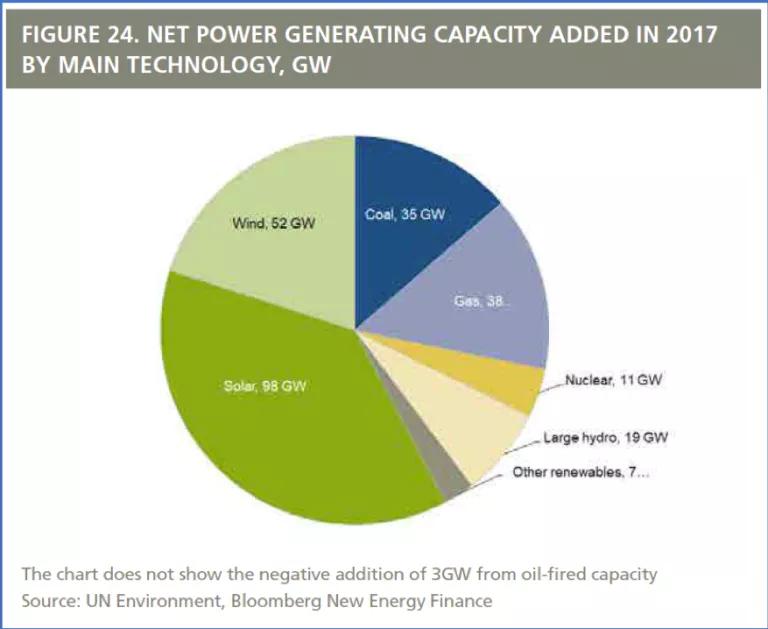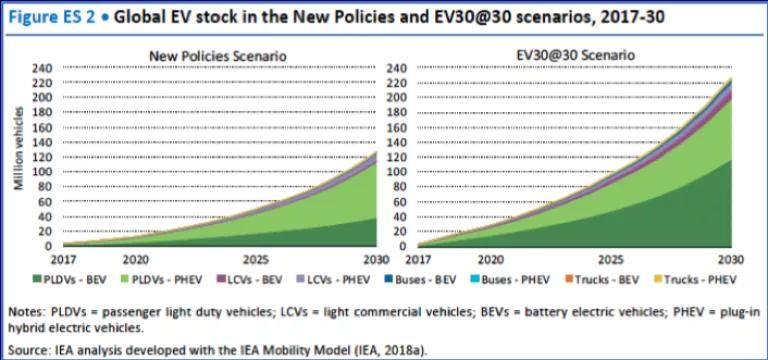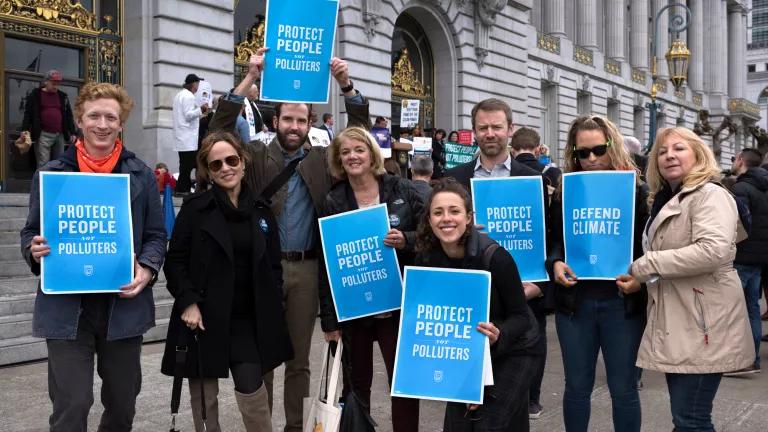Action Marches on Despite Trump's Paris Agreement Decision

A year ago today, President Trump announced he was launching an assault on our children’s future, American companies, and all the countries in the world. Standing in the Rose Garden, Trump signaled his intent to withdraw the United States from the Paris Agreement, a reckless attempt to undermine a historic global agreement that, for the first time, secured specific commitments from all major countries and a path to strengthen domestic climate action in the years ahead.
One year later, despite that terrible decision, despite his continued false claims, the world has news for the president: Climate action is still marching firmly forward. And, in fact, there are clear signs that action is accelerating.
More countries have joined the Paris Climate Agreement since President Trump’s announcement
As of June 1, 2017 (the day of Trump’s speech), 148 countries (including the U.S.) had joined the Paris Agreement. One year later, twenty-nine more countries have joined the agreement, bringing the total to 177 countries (see figure). Not a single other country has signaled it will withdraw from the Agreement. The U.S. is the only country in the world that has announced it will withdraw from this historic agreement.
Formally, Trump can’t withdraw the U.S. from the Paris Agreement until November 4, 2020 (one day after the next Presidential election). But even if he does take that step, the U.S. could rejoin the agreement under the next president with a mere 30 day wait period.
Countries keep advancing the goals by implementing more climate action
There are also clear signs that the countries in Paris are increasing their commitments and actions. As Christiana Figueres, former head of the UN Framework Convention on Climate Change, put it: “despite the White House decision, climate action is continuing around the world as other nations keep to their pledges and sub-national entities double theirs.” You can see signs of this in the new laws enacted by national governments around the world. Forty-two new laws were adopted to date by countries in 2017-2018 , according to researchers at the Grantham Research Institute on Climate Change and the Environment and the Sabin Center on Climate Change Law at the Columbia Law School. And these numbers don’t count the underlying policies and changing investments that are happening on a daily basis throughout the world.
China’s coal consumption has still peaked amidst signs of meeting its targets early
China’s coal consumption peaked in 2013, marking a significant turnaround from the 8-10 percent annual growth rate prior to that peak year. For the next three years, coal consumption either declined or remained flat. This caused China’s overall carbon dioxide emissions declining or remaining flat, according to several studies (see here and here). This is a huge turnaround, as almost all China analysts had been consistently predicting that China’s total carbon dioxide emissions would continue to grow well past 2030.
While China’s overall coal consumption increased by 0.4% in 2017 and has continued to rise in the first quarter of 2018, total coal consumption is still hovers below the 2013 peak level. China has set a mandatory coal cap target to reduce the share of coal in its energy consumption to 58 percent or less by 2020. China, which had led the world in renewables investments since 2011, added another $126.6 billion in investments in wind, solar and other renewable energy in 2017, more than triple the United States’ $40.5 billion. This renewable energy deployment, coupled with a “war on pollution” aimed at addressing the country’s air pollution challenges and energy efficiency improvements have created strong conditions for China’s carbon dioxide emissions to peak well before 2030, as originally outlined in the Paris Agreement. More action is needed to decisively cap and reduce coal and oil consumption, but China's top climate envoy, Xie Zhenhua, has said that he believes “[China] could meet its pledge to cap carbon emissions ahead of its target”.
India’s renewable energy and energy efficiency is still advancing
India has set an ambitious near-term renewable energy goal of 175 gigawatts by 2022. The recent 2018 National Electricity Plan reaffirms India’s plan to expand renewable energy capacity to 275 GW by 2027, with solar energy accounting for a majority of the total.
India’s promising large utility-scale solar market is growing with innovative solar parks as a global trend-setter. And the market is responding with record-low bids for solar (2.44 Rs/$.04 per kWh) and wind (3.46 Rs/$.05 per kWh) tariffs in recent months. This stunning growth in solar, and wind energy too, has prompted several Indian states to scrap plans for new coal-fired power plants and announce the cancellation of coal mining projects.
We are also seeing progress in India’s energy efficiency efforts. To beat the heat without harming the environment, India is developing a combination of strategies, including climate-friendly air conditioners, cool roofs and energy efficient buildings. Buildings account for more than 30 percent of India’s electricity consumption, with a significant expansion of total built-up space occurring. That is why the State of Telangana and the hi-tech capital, Hyderabad, set up an online system for mandatory energy efficiency codes for commercial buildings. More Indian cities are poised to adopt additional steps to ensure that their buildings use less energy. And while less than 10 percent of Indian households currently use air conditioners, but sales are increasing rapidly every year. So it is a positive sign that the Indian market already has more than 50 room air conditioner models that meet a four-star or above rating (India’s highest efficiency level rating levels).
Booming renewables in Latin America
Latin America continues to draw huge investments in clean energy, with the region’s renewable energy sector growing at 25 times faster than the global rate. For the second year in a row, Bloomberg New Energy Finance’s annual Climatescope concluded that 4 of the top 10 developing countries for clean energy are in Latin America (Brazil, Mexico, Chile, and Uruguay). For the first time ever, all of the power plants in construction in Chile are renewable, while the new administration has committed to phase out coal-fired power plants.
Renewable energy continues to be the investment of choice
While fossil fuel consumption isn’t declining (yet) as fast as required to put the world on a climate safe trajectory, there are clear signs that renewable energy has become the smart investment. According to a new study, a record 157 gigawatts (GW) of renewable power were commissioned in 2017, a noticeable increase from the 143 GW commissioned in 2016. This renewable power additions were significantly larger than the 70 GW of net fossil fuel generating capacity added in 2017.

Smart investors are recognizing the inherent risks of continued investments in fossil fuels as these types of projects no longer make long-term sense for their bottom-line. Take coal – the most carbon-intensive power source, for example: Allianz, a major insurer with 664 billion Euros of investments, has announced it will stop insuring coal projects. Major banks with hundreds of billions of dollars in assets recognize that investing in coal is risky and irresponsible, that’s why 15 of the world’s largest have announced a ban on financing new coal plants or coal mines (i.e. Societe Generale and Deutsche Bank). Some have ended direct financing for new mines (i.e. JPMorgan Chase & Co., HSBC, and Credit Suisse), while others have gone further to focus on developers who use general corporate financing for coal projects. And, just this week, the Royal Bank of Scotland in the UK announced that it would eliminate financing for new coal fired power stations, new thermal coal mines, oil sands projects, or Arctic oil projects. RBS will also tighten lending restrictions for mining companies generating more than 40 percent of their revenues from thermal coal and power companies generating more than 40 percent of their electricity from coal.
Electric vehicles are going mainstream
In just the past few months there have been clear signs that electric vehicles are no longer a side market. The growth of electric vehicles would put significant downward pressure on climate pollution, displacing oil consumption that is currently projected to increase carbon dioxide emission without new efforts. According to Bloomberg New Energy Finance (BNEF), electric vehicle sales could reach over 1.6 million this year – up from only a few hundred thousand in 2014.
The International Energy Agency projects that under current trends the number of electric cars on the road will reach 125 million by 2030 (see figure). China, Europe, and the U.S. (led by California) are projected to lead the way with their mandatory policies to drive larger electric vehicle sales. But other countries are poised for greater action, with some promising (but mixed) signals from India and promising signs in Latin America. Reading the trends, smart automakers have been announcing plans to bring even more electric vehicles to the market. According to BNEF, by 2022 there will be 289 electric vehicle models offered for sale around the world – almost double the number offered in 2017.

American states, cities, companies, and investors continue to move forward
In response to President Trump’s announcement, American states, cities, companies, and investors signaled that they will continue to deliver even stronger action to make every effort to ensure that the U.S. stays in the Paris Agreement. And a number of states and cities have adopted new policies to begin to deliver on those signals. To date, 29 states plus Washington D.C. have renewable energy portfolio standards, at least 20 states have mandatory energy efficiency resource standards, and eight more have energy efficiency standard goals. After Trump’s announcement, the governors of 16 states and Puerto Rico formed the U.S. Climate Alliance with a commitment to meet U.S. Paris climate accord goals. The nine states participating in the Regional Greenhouse Gas Initiative (RGGI) agreed to cut power plant carbon pollution by at least 30 percent more through 2030. Following the example of California, a growing number of states are scaling up electric vehicles and a group of Northeast and Mid-Atlantic states are also exploring plans to cut carbon from the transportation sector. Virginia is moving forward with plans to develop a state climate cap-and-trade program, creating a path to joining RGGI. New York State has announced aggressive new energy efficiency plans and a plan to tap into the offshore wind potential in the state. Pennsylvania adopted stronger building energy efficiency codes which will result in the significantly less energy used in new residential and commercial buildings. California continues to lead the way by enacting an air quality and climate package that will extend its market-based cap-and-trade program to 2030.
And leading American cities continue to become even more efficient and reduce their carbon pollution. With great news today that the former New City Mayor Bloomberg has announced a new American Cities Climate Challenge to help the nation's 20 biggest cities achieve their climate goals. The cities selected will be able to tap into new resources to help consult with transportation and building experts, hire professional help to design, plan, and implement programs to improve building efficiency and affordable public transit; train key city officials; and enhance civic engagement to make sure clean energy strategies reflect local priorities. This new challenge will help cities build on the progress they are already making by empowering them to win the global battle against climate change by looking to their own backyards.
President Trump thought he would spark an exodus from the Paris Agreement—he was wrong
When President Trump announced his intention to pull the U.S. out of the Paris Agreement everyone wondered how the world would react. Would climate action stall or would leaders step-up with stronger measures? They answered with a clear response: more clean energy, better vehicles, more climate action, and more entities coming forward to fill the void of U.S. leadership.
Action marches on in spite of President Trump.




